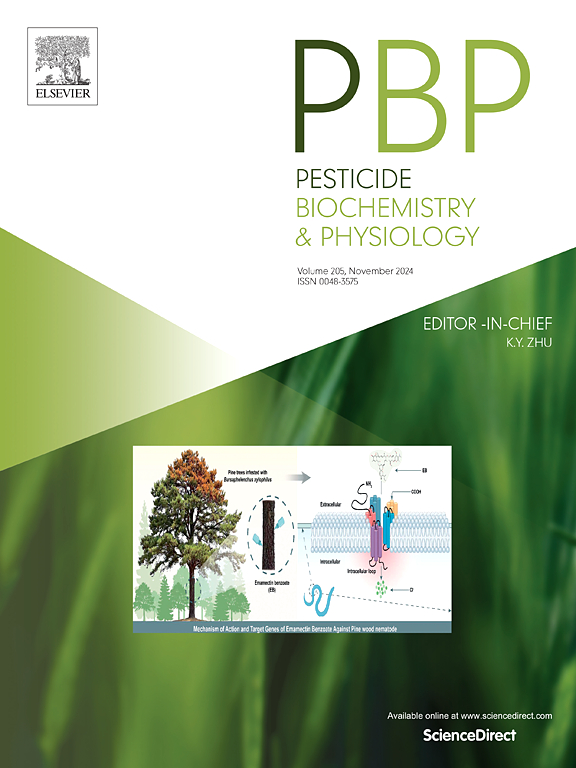CRISPR/Cas9敲除nAChR α6使西方富兰克林菌对spinosyns产生抗性,并且与靶位点突变G275E相比具有更高的适应度成本
IF 4.2
1区 农林科学
Q2 BIOCHEMISTRY & MOLECULAR BIOLOGY
引用次数: 0
摘要
蓟马是全球主要的农业害虫,通常使用spinosad和spinetoram等spininosyn杀虫剂来控制它们。然而,已经出现了许多耐药病例,通常与尼古丁乙酰胆碱受体(nAChR) α6亚基的突变有关,这是spinosyns的主要分子靶点。本研究从一株西方富兰克林菌的敏感菌株和两株携带G275E抗性突变的田间抗性菌株中获得了spinosad和spinetoram的毒理学数据。值得注意的是,在一个野外收集的种群中发现了一种新的候选耐药突变T202A,并讨论了其在耐药中的可能作用。此外,在易感菌株中进行了CRISPR/ cas9介导的α6敲除(KO),以阐明之前在田间观察到的这种抗性机制的表型强度。尽管高剂量的spinetoram仍然是致命的,但KO对spinosad完全不敏感,对spinetoram有明显的耐药性,这表明可能与次要靶点相互作用。最后,在实验进化方法中,α6 KO等位基因迅速消失,表明存在巨大的适应度成本。相比之下,G275E等位基因持续存在。本文章由计算机程序翻译,如有差异,请以英文原文为准。
CRISPR/Cas9 knock-out of nAChR α6 confers resistance to spinosyns in Frankliniella occidentalis and is associated with a higher fitness cost than target-site mutation G275E
Thrips are major agricultural pests globally and spinosyn insecticides like spinosad and spinetoram are commonly used for their control. However, numerous cases of resistance have emerged, often linked to mutations in the nicotinic acetylcholine receptor (nAChR) α6 subunit, the main molecular target of spinosyns. In this study, toxicological data for spinosad and spinetoram were obtained from a susceptible strain of Frankliniella occidentalis, as well as two field-collected resistant strains carrying the G275E resistance mutation. Notably, a new candidate resistance mutation never reported before, T202A, was identified in one of the field collected populations and its possible role in resistance is discussed. Further, CRISPR/Cas9-mediated knockout (KO) of α6 was performed in the susceptible strain to shed light on the phenotypic strength of this resistance mechanism previously observed in the field. The KO conferred complete insensitivity to spinosad and significant resistance to spinetoram, although higher doses of spinetoram remained lethal, suggesting potential interaction with a secondary target. Finally, in an experimental evolution approach, the α6 KO allele rapidly disappeared, indicating a substantial fitness cost. In contrast, G275E alleles persisted.
求助全文
通过发布文献求助,成功后即可免费获取论文全文。
去求助
来源期刊
CiteScore
7.00
自引率
8.50%
发文量
238
审稿时长
4.2 months
期刊介绍:
Pesticide Biochemistry and Physiology publishes original scientific articles pertaining to the mode of action of plant protection agents such as insecticides, fungicides, herbicides, and similar compounds, including nonlethal pest control agents, biosynthesis of pheromones, hormones, and plant resistance agents. Manuscripts may include a biochemical, physiological, or molecular study for an understanding of comparative toxicology or selective toxicity of both target and nontarget organisms. Particular interest will be given to studies on the molecular biology of pest control, toxicology, and pesticide resistance.
Research Areas Emphasized Include the Biochemistry and Physiology of:
• Comparative toxicity
• Mode of action
• Pathophysiology
• Plant growth regulators
• Resistance
• Other effects of pesticides on both parasites and hosts.

 求助内容:
求助内容: 应助结果提醒方式:
应助结果提醒方式:


